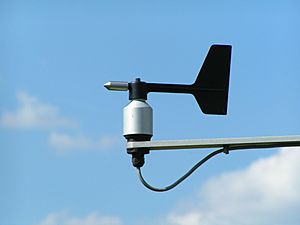Weather vane facts for kids
A weather vane is a tool that spins freely to show you which way the wind is blowing. For hundreds of years, weather vanes were important for showing wind direction and how fast the wind was moving. They helped people with farming, travel, and shipping. Today, they are mostly used for decoration. Newer, special weather instruments have taken their place.
To work best, a weather vane should be on the highest part of a building. It needs to be far away from anything that could block the wind. The simplest weather vane is a horizontal arrow or shape that spins on a vertical pole. When the wind blows, the arrow points in the direction the wind is coming from.
The word 'vane' comes from an old English word meaning 'banner' or 'cloth'.
Contents
History of Weather Vanes
The idea of a weather vane is very old. The earliest known weather vane was made around 48 BC. An astronomer named Andronicus created it. This ancient weather vane sat on top of the Tower of the Winds in Athens, Greece. It was shaped like a man's head and body with a fish tail. It was about 4 to 8 feet long.
In ancient China, people also used devices to check the wind. Around 139 BC, a book called Huainanzi mentioned a "wind-observing fan." By the 3rd century, Chinese weather vanes looked like birds. They were called "wind-indicating birds." One was even described on a tower roof in a book about palaces.
Rooster Weather Vanes
The oldest weather vane shaped like a rooster is called the Gallo di Ramperto. It was made in 820 AD. You can see it today in a museum in Brescia, Italy.
Rooster weather vanes became popular on church steeples. Pope Gregory I said the rooster was a good symbol for Christianity. This was because of a story in the Bible where Jesus predicts that Saint Peter will deny him three times before a rooster crows.
Because of this, roosters started appearing on church steeples. In the 9th century, Pope Nicholas I even ordered that every church steeple should have one. The Bayeux Tapestry, made in the 1070s, shows a person putting a rooster on Westminster Abbey.
Some people think the rooster on churches also symbolized the clergy (church leaders) being watchful. They would call people to prayer. Another idea is that the rooster was a symbol of the sun from an older culture.
Some churches use weather vanes shaped like symbols of their patron saints. For example, a church in London named after St. Peter has a key-shaped weather vane. Another church named after St. Lawrence has a gridiron (a cooking tool) as its weather vane.
Modern Weather Vanes
Early weather vanes often had fancy designs. But modern weather vanes are usually simple arrows. They often don't have the direction letters (N, S, E, W) on them. This is because they are connected to a remote station that reads the wind direction.
An early example of this was at the British Admiralty building in London. The weather vane on the roof was connected to a large dial inside a meeting room. This way, officers always knew the wind direction during their meetings.
Modern devices called aerovanes combine a weather vane with an anemometer. An anemometer is a tool that measures wind speed. Having both together means they can use the same pole. This gives a combined reading of both wind direction and speed.
World's Largest Weather Vanes
There are a few very large weather vanes around the world.
According to Guinness World Records, the biggest weather vane is a Tío Pepe sherry advertisement. It is located in Jerez de la Frontera, Spain.
The city of Montague, Michigan also says it has the largest standard weather vane. It looks like a ship and an arrow. It is 48 feet tall, and its arrow is 26 feet long.
Another very large weather vane is in Whitehorse, Yukon, Canada. This weather vane is actually a retired Douglas DC-3 airplane! It sits on a spinning support at the Yukon Transportation Museum. Pilots use it to see wind direction. Tourists also enjoy it as a landmark. This huge weather vane only needs a light wind (5 knots) to turn.
In Westlock, Alberta, Canada, there is a challenger for the world's tallest weather vane. This classic weather vane is 50 feet tall. On top of it is a 1942 Case Model D Tractor. You can find this landmark at the Canadian Tractor Museum.
Related pages
- Windsock
- Apparent wind indicator
- List of weather instruments
- Old Father Time, a famous weather vane at Lord's Cricket Ground, London
- Weather radar
- Weather station
- Weather balloon
Images for kids
-
A moose shaped weather vane -
A mermaid weather vane -
A Douglas DC-3 converted to a weather vane -
A rooster weather vane (also called a weathercock) -
A whale weather vane -
Clock tower in Belgium with weather vanes
See also
 In Spanish: Veleta para niños
In Spanish: Veleta para niños

















